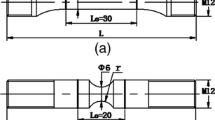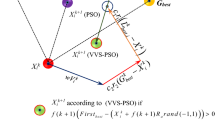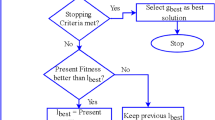Abstract
The crack growth trajectory is a significant structural issue, directly affecting its quality and stability. Specifically, a crack propagating toward a critical condition will fail the structure. On the other hand, cutouts in a structure can deviate from the crack path; hence, the position of a cutout is one of the most influential parameters in crack path deviation. It is essential to obtain the most optimal position since a cutout may be located at different positions relative to the crack. In order to determine the optimal cutout position to extend the fatigue life, the present manuscript investigated a suitable position for the center of a constant-radius circular cutout by optimizing an objective function using the Particle Swarm Optimization (PSO) algorithm. The results indicated that the vertical position of the cutout to the crack is influential in crack path deviation. Subsequently, the results obtained from a coupling between the PSO and Extended Finite Element Method (XFEM) were validated via experiments. It was concluded that numerical results are in good agreement with experimental results.




















Similar content being viewed by others
Data availability
The datasets generated during the current study are available from the corresponding author upon reasonable request.
References
Dimatteo ND, Lampman SR (1996). Fatigue and fracture, (ed) vol. 19, ASM Handbook
Ghazwan Q, Al M (2017) High cycle fatigue (HCF) testing of steel for fedral aviation administration (FAA) part qualification. California State University
Chapetti Mirco D (2002) Estimation of the plain high-cycle fatigue propagation resistance in steels. Mater Res 2:101–105
Sander M, Richard HA (2006) Experimental and numerical investigations on the influence of the loading direction on the fatigue crack growth. Int J Fatigue 28:583–591
Ding F, Zhao T, Jiang Y, Ding F, Zhao T (2007) A study of fatigue crack growth with changing loading direction. Eng Fract Mech 74:2014–2029
Seifi R, Ghadimian O, Ranjbaran M (2015) Study on life and path of fatigue cracks in multiple site damage plates. Int J Fatigue 80:449–458
Liao Y, Li Y, Huang M, Wang B, Yang B, Pei S (2019) Effect of hole relative size and position on crack deflection angle of repaired structure. Theoret Appl Fract Mech 101:92–102
Reis L, Li B, Freitas M (2009) Crack initiation and growth path under multiaxial fatigue loading in structural steels. Int J Fatigue 31:1660–1668
Makabe C, Murdani A, Kuniyoshi K, Irei Y, Saimoto A (2009) Crack-growth arrest by redirecting crack growth by drilling stop holes and inserting pins into them. Eng Fail Anal 16:475–483
Ayatollahi MR, Zakeri M (2017) An improved definition for mode I and mode II crack problems. Eng Fract Mech 175:235–246
Saber A, Shariati M (2016), Taguchi statistical analysis of experiments on the effect of cutout on crack growth and fatigue life of ck45 steel. In 5th International conference on electrical, computer, mechanical and mechatronics engineering, Istanbul
Hu XF, Yao WA (2013) A new enriched finite element for fatigue crack growth. Int J Fatigue 48:247–256
Bashir R, Xue H, Zhang J, Guo R, Hayat R, Li G, Bi Y (2020) Effect of XFEM mesh density (mesh size) on stress intensity factors, strain gradient and stress corrosion cracking (SCC) growth rate. Structures 25:593–602
Chabouk E, Shariati M, Kadkhodayan M, Masoudi Nejad R (2021) Fatigue assessment of 2024–T351 aluminum alloy under uniaxial cyclic loading. J Mater Eng Perform 30(4):2864–2875
Krishnapillai K, Jones R (2009) Three-dimensional structural design optimisation based on fatigue implementing a genetic algorithm and a non-similitude crack growth law. Finite Elem Anal Des 45:132–146
ASTM (2001) Standard test methods for tension testing of metallic materials, Annual book of ASTM standards, (ed), Vol E8–E99, ASTM
Blazic M, Maksimovic S, Petrovic Z, Vasovic A, Turnic D (2014) Determination of fatigue crack growth trajectory and residual life under mixed modes. J Mech Eng 60:250–254
Perez N (2004), (ed) Fracture mechanics. Kluwer Academic Publishers, Boston
Ratnaweera A, Halgamuge S, Harry WC (2004) Self-organizing hierarchical particle swarm optimizer with time-varying acceleration coefficients. IEEE Trans Evol Comput 3:240–255
Engelbrecht Andries P (2007) Computational intelligence, Second, Edition. Wiley, University of Pretoria South Africa
Hosseini S, Hamidi S, Mansuri M, Ghoddosian A (2015) Multi objective particle swarm optimization (MOPSO) for size and shape optimization of 2D truss structures. Period Polytech Civ Eng 59:9–14
Jafari M, Salajegheh E, Salajegheh J (2021) Optimal design of truss structures using a hybrid method based on particle swarm optimizer and cultural algorithm. Structures 32:391–405
Keshavarzian H, Daneshjou K (2020) PSO-based online estimation of aerodynamic ground effect in the backstepping controller of quadrotor. J Braz Soc Mech Sci Eng 42:1–10
Cleghorn CW, Engelbrecht AP (2018) Particle swarm stability: a theoretical extension using the non-stagnate distribution assumption. Swarm Intell 12:1–22
Bonyadi M, Michalewicz Z (2016) Stability analysis of the particle swarm optimization without stagnation assumption. IEEE Trans Evol Comput 20:814–819
Qunfeng L (2015) Order-2 stability analysis of particle swarm optimization. Evol Comput 23:187–216
Li XL, Serra R, Olivier J (2021) An investigation of particle swarm optimization topologies in structural damage detection. Appl Sci 11(11):5144
Ozgur Y (2005) Penalty function methods for constrained optimization with genetic algorithms. Math Comput Appl 10:45–56
Singh I, Mishra B, Bhattacharya S, Patil R (2012) The numerical simulation of fatigue crack growth using extended finite element method. Int J Fatigue 36:109–119
Ding J, Yu T, Yang Y, Bui TQ (2020) An efficient variable-node XFEM for modeling multiple crack growth: a Matlab object-oriented implementation. Adv Eng Softw 140:102750
Latifi Rostami SA, Ghoddosian A, Kolahdooz A, Zhang J (2022) Topology optimization of continuum structures under geometric uncertainty using a new extended finite element method. Eng Optim 54(10):1692–1708
Martínez E, Farias M, Evangelista Junior F (2019) Investigation of the notch angle in hydraulic fracturing using XFEM. J Braz Soc Mech Sci Eng 41:1–13
Ayatollahi MR, Razavi SMJ, Yahya MY (2015) Mixed mode fatigue crack initiation and growth in a CT specimen repaired by stop hole technique. Eng Fract Mech 145:115–127
Becker WT, Lampman S (2002) Fracture appearance and mechanisms of deformation and fracture. Mater Park, OH: ASM Int 2002:559–586
Lesiuk G, Rymsza B, Rabiega J, Correia J, Jesus A, Calcada R (2019) Influence of loading direction on the static and fatigue fracture properties of the long term operated metallic materials. Eng Fail Anal 96:409–425
Author information
Authors and Affiliations
Corresponding author
Ethics declarations
Conflict of interest
The authors declare that they have no known competing financial interests or personal relationships that could have appeared to influence the work reported in this paper.
Additional information
Technical Editor: João Marciano Laredo dos Reis.
Publisher's Note
Springer Nature remains neutral with regard to jurisdictional claims in published maps and institutional affiliations.
Rights and permissions
Springer Nature or its licensor (e.g. a society or other partner) holds exclusive rights to this article under a publishing agreement with the author(s) or other rightsholder(s); author self-archiving of the accepted manuscript version of this article is solely governed by the terms of such publishing agreement and applicable law.
About this article
Cite this article
Saberian, M., Ghoddosian, A. & Ghasemi-Ghalebahman, A. Computational intelligent optimization approach based on Particle Swarm Optimization and Extended Finite Element Method for high-cycle fatigue life extension. J Braz. Soc. Mech. Sci. Eng. 45, 93 (2023). https://doi.org/10.1007/s40430-022-03935-8
Received:
Accepted:
Published:
DOI: https://doi.org/10.1007/s40430-022-03935-8




